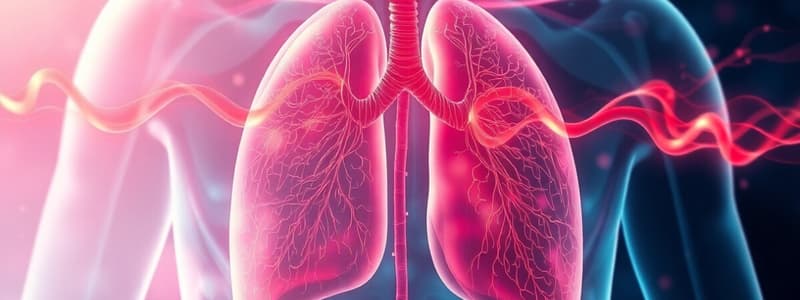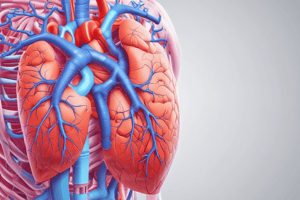Podcast
Questions and Answers
What is the primary function of pulmonary circulation?
What is the primary function of pulmonary circulation?
- To connect the heart with the lungs for oxygen exchange (correct)
- To circulate blood throughout the entire body
- To deliver nutrients to body cells
- To transport deoxygenated blood to the heart
What happens to blood after it delivers oxygen to the body cells?
What happens to blood after it delivers oxygen to the body cells?
- It becomes oxygenated and returns to the lungs
- It is pumped back through the aorta
- It becomes deoxygenated and carries waste products (correct)
- It is stored in the heart until needed
Which vessels carry oxygenated blood from the lungs to the heart?
Which vessels carry oxygenated blood from the lungs to the heart?
- Inferior vena cava
- Pulmonary arteries
- Pulmonary veins (correct)
- Superior vena cava
Which artery is the main vessel that transports blood directly away from the heart?
Which artery is the main vessel that transports blood directly away from the heart?
How long does it take for a drop of blood to travel from the heart to the toes and back?
How long does it take for a drop of blood to travel from the heart to the toes and back?
What is the role of veins in the circulatory system?
What is the role of veins in the circulatory system?
What is carried away from the body cells in the deoxygenated blood?
What is carried away from the body cells in the deoxygenated blood?
Which of the following veins collect blood from smaller veins and transport it back to the heart?
Which of the following veins collect blood from smaller veins and transport it back to the heart?
Flashcards
Pulmonary Circulation
Pulmonary Circulation
The circulation of blood between the heart and lungs.
Oxygenation
Oxygenation
The process where blood absorbs oxygen in the lungs and transports it throughout the body.
Deoxygenated Blood
Deoxygenated Blood
Blood that has delivered oxygen to cells and picked up waste products like carbon dioxide.
Aorta
Aorta
Signup and view all the flashcards
Superior and Inferior Vena Cava
Superior and Inferior Vena Cava
Signup and view all the flashcards
Cardiac Muscle
Cardiac Muscle
Signup and view all the flashcards
Systemic Circulation
Systemic Circulation
Signup and view all the flashcards
Waste Removal
Waste Removal
Signup and view all the flashcards
Study Notes
Pulmonary Circulation Overview
- Pulmonary circulation is the blood flow between the heart and lungs.
- Blood travels from the heart to the lungs, picks up oxygen, and returns to the heart.
- Blood travels approximately 1 meter/second (3.6 km/hr) in the resting state. Speed decreases in smaller vessels.
- A complete trip from the heart to the toes and back takes about a minute.
- Veins carry blood to the heart; arteries away from the heart.
Oxygenation Process
- Blood absorbs oxygen in the lungs, becoming oxygenated.
- Oxygenated blood travels through pulmonary veins to the heart's left atrium.
- Cells need oxygen to survive.
- Deoxygenated, waste-filled blood (carbon dioxide) is pumped to the lungs via pulmonary arteries.
- Lungs remove carbon dioxide and replenish oxygen.
- This cycle repeats continuously.
Systemic Circulation Connection
- Oxygenated blood from the heart travels throughout the body through arteries.
- Aorta is the main artery leaving the heart.
- Arteries branch into smaller ones (liver, intestinal, renal).
- Deoxygenated blood returns to the heart through veins.
- Superior and Inferior Vena Cava are the main veins returning to the heart.
- Blood from organs flows into smaller veins.
Coronary Circulation
- The heart muscle (cardiac muscle) needs a blood supply.
- Coronary arteries branch off the aorta to supply oxygenated blood to the heart muscle.
- Deoxygenated blood from the heart muscle returns via coronary veins back into pulmonary arteries.
Types of Muscle Tissue
- Voluntary (skeletal) muscle is strong.
- Involuntary (smooth) muscle is weak but not quickly tiring.
- Cardiac muscle combines properties of both types.
Studying That Suits You
Use AI to generate personalized quizzes and flashcards to suit your learning preferences.




